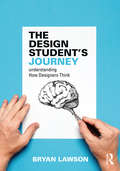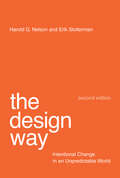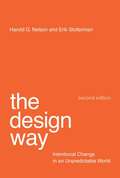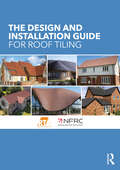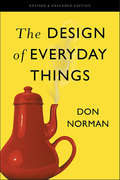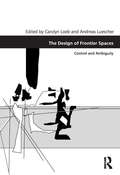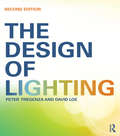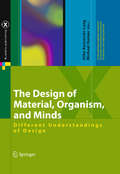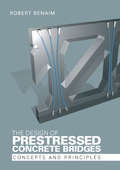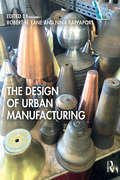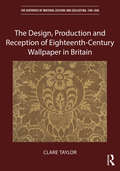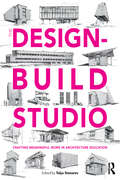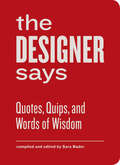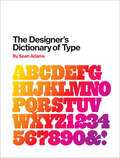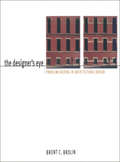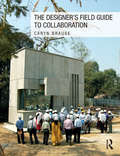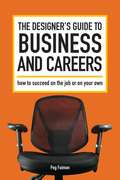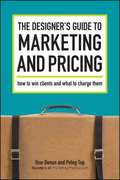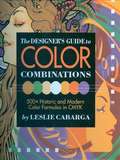- Table View
- List View
The Design Student's Journey: understanding How Designers Think
by Bryan LawsonBeing a professional designer is one of the most intellectually rewarding careers. Learning to become a designer can be tremendous fun but it can also be frustrating and at times painful. What you have to do to become a designer is not often clearly laid out and can seem mysterious. Over the past 50 years or so we have discovered a great deal about how designers think. This book relies upon that knowledge but presents it in a way specifically intended to help the student and perhaps the teacher. Bryan Lawson’s classic book How Designers Think has been in print since 1980 and has gone through four editions to keep it up to date. This book can be seen as a companion volume for the design student.
The Design Thinking Playbook: Mindful Digital Transformation of Teams, Products, Services, Businesses and Ecosystems
by Larry Leifer Michael Lewrick Patrick LinkA radical shift in perspective to transform your organization to become more innovative The Design Thinking Playbook is an actionable guide to the future of business. By stepping back and questioning the current mindset, the faults of the status quo stand out in stark relief—and this guide gives you the tools and frameworks you need to kick off a digital transformation. Design Thinking is about approaching things differently with a strong user orientation and fast iterations with multidisciplinary teams to solve wicked problems. It is equally applicable to (re-)design products, services, processes, business models, and ecosystems. It inspires radical innovation as a matter of course, and ignites capabilities beyond mere potential. Unmatched as a source of competitive advantage, Design Thinking is the driving force behind those who will lead industries through transformations and evolutions. This book describes how Design Thinking is applied across a variety of industries, enriched with other proven approaches as well as the necessary tools, and the knowledge to use them effectively. Packed with solutions for common challenges including digital transformation, this practical, highly visual discussion shows you how Design Thinking fits into agile methods within management, innovation, and startups. Practical frameworks, real-world solutions, and radical innovation wrapped in a whole new outlook give you the power to mindfully lead to new heights. From systems and operations to people, projects, culture, digitalization, and beyond, this invaluable mind shift paves the way for organizations—and individuals—to do great things. When you’re ready to give your organization a big step forward, The Design Thinking Playbook is your practical guide to a more innovative future.
The Design Way, second edition: Intentional Change in an Unpredictable World
by Erik Stolterman Harold G. NelsonA book that lays out the fundamental concepts of design culture and outlines a design-driven way to approach the world.Humans did not discover fire—they designed it. Design is not defined by software programs, blueprints, or font choice. When we create new things—technologies, organizations, processes, systems, environments, ways of thinking—we engage in design. With this expansive view of design as their premise, in The Design Way Harold Nelson and Erik Stolterman make the case for design as its own culture of inquiry and action. They offer not a recipe for design practice or theorizing but a formulation of design culture's fundamental core of ideas. These ideas—which form “the design way”—are applicable to an infinite variety of design domains, from such traditional fields as architecture and graphic design to such nontraditional design areas as organizational, educational, interaction, and healthcare design.The text of this second edition is accompanied by new detailed images, “schemas” that visualize, conceptualize, and structure the authors' understanding of design inquiry. The text itself has been revised and expanded throughout, in part in response to reader feedback.
The Design Way: Intentional Change in an Unpredictable World (Second Edition)
by Erik Stolterman Harold G. NelsonHumans did not discover fire--they designed it. Design is not defined by software programs, blueprints, or font choice. When we create new things--technologies, organizations, processes, systems, environments, ways of thinking--we engage in design. With this expansive view of design as their premise, in The Design Way Harold Nelson and Erik Stolterman make the case for design as its own culture of inquiry and action. They offer not a recipe for design practice or theorizing but a formulation of design culture's fundamental core of ideas. These ideas--which form "the design way"--are applicable to an infinite variety of design domains, from such traditional fields as architecture and graphic design to such nontraditional design areas as organizational, educational, interaction, and healthcare design. The text of this second edition is accompanied by new detailed images, "schemas" that visualize, conceptualize, and structure the authors' understanding of design inquiry. The text itself has been revised and expanded throughout, in part in response to reader feedback.
The Design and Installation Guide for Roof Tiling
by The Roof Association The National Roofing ContractorsThe Design and Installation Guide for Roof Tiling is the definitive guide to obtaining successful results in pitched roofing construction using clay or concrete tiles. It was written by a team of experts from the Roof Tile Association (RTA) and the National Federation of Roofing Contractors (NFRC), the representative trade associations for pitched roofing. This book is in line with British and European Standards, the latest best site practices and industry recommendations to ensure readers are receiving the most up-to-date and accurate information available in the field.Based on actual teaching practice, this book is highly illustrated throughout to increase the accessibility of the text for the reader in their exploration of the practical aspects of roofing. It also includes an extensive glossary of roofing terms for ease of reference. It brings together a comprehensive collection of the design, material specifications and workmanship requirements to construct a successful tiled pitched roof, including:• up-to-date design, product and workmanship standards• current best site practice• advances in health and safety• current typical scope of works for a roofing contractor• broad knowledge of the overall building envelope performance; specifically, the increasing insulation and airtightness requirements.Students following diploma (Foundation, Intermediate and Advanced levels) and apprenticeship routes will find this book to be an invaluable reference source of information that will accompany them throughout their studies. Building professionals concerned with the design, detailing and specification of roofing will also find this book to be an essential reference.
The Design of Everyday Things: Revised and Expanded Edition
by Don NormanOne of the world's great designers shares his vision of "the fundamental principles of great and meaningful design", that's "even more relevant today than it was when first published" (Tim Brown, CEO, IDEO). Even the smartest among us can feel inept as we fail to figure out which light switch or oven burner to turn on, or whether to push, pull, or slide a door. The fault, argues this ingenious -- even liberating -- book, lies not in ourselves, but in product design that ignores the needs of users and the principles of cognitive psychology. The problems range from ambiguous and hidden controls to arbitrary relationships between controls and functions, coupled with a lack of feedback or other assistance and unreasonable demands on memorization. The Design of Everyday Things shows that good, usable design is possible. The rules are simple: make things visible, exploit natural relationships that couple function and control, and make intelligent use of constraints. The goal: guide the user effortlessly to the right action on the right control at the right time. The Design of Everyday Things is a powerful primer on how -- and why -- some products satisfy customers while others only frustrate them.
The Design of Frontier Spaces: Control and Ambiguity (Design and the Built Environment)
by Andreas Luescher Carolyn LoebIn a globalizing world, frontiers may be in flux but they remain as significant as ever. New borders are established even as old borders are erased. Beyond lines on maps, however, borders are spatial zones in which distinctive architectural, graphic, and other design elements are deployed to signal the nature of the space and to guide, if not actually control, behaviour and social relations within it. This volume unpacks how manipulations of space and design in frontier zones, historically as well as today, set the stage for specific kinds of interactions and convey meanings about these sites and the experiences they embody. Frontier zones organize an array of functions to facilitate the passage of goods, information, and people, and to define and control access. Bringing together studies from Asia, Africa, the Middle East, Europe, and North America, this collection of essays casts a wide net to consider borders of diverse sorts. Investigations of contemporary political frontiers are set within the context of examinations of historical borders, borders that have existed within cities, and virtual borders. This range allows for reflection on shifts in how frontier zones are articulated and the impermanence of border emplacements, as well as on likely scenarios for future frontiers. This text is unique in bringing together a number of scholarly perspectives in the arts and humanities to examine how spatial and architectural design decisions convey meaning, shape or abet specific social practices, and stage memories of frontier zones that no longer function as such. It joins and expands discussions in social science disciplines, in which considerations of border practices tend to overlook the role of built form and material culture more broadly in representing social practices and meanings.
The Design of Lighting
by Peter Tregenza David LoeThis fully updated edition of the successful book The Design of Lighting, provides the lighting knowledge needed by the architect in practice, the interior designer and students of both disciplines. The new edition offers a clear structure, carefully selected material and linking of lighting with other subjects, in order to provide the reader with a comprehensive and specifically architectural approach to lighting. Features of this new edition include: technical knowledge of lighting in the context of architectural design; an emphasis on imagination in architectural light and presentation of the tools necessary in practice for creative design; additional chapters on the behaviour of light and on the context of design; a strong emphasis on sustainable design and energy saving, with data and examples; analyses of actual lighting schemes and references to current standards and design guides; an up-to-date review of lamp and lighting technology, with recommendations on the choice of equipment; a revision of the calculation section, with examples and step-by-step instructions, based on recent student feedback about the book.
The Design of Material, Organism, and Minds
by Michael Hampe Silke Konsorski-LangDesign is eminent throughout different disciplines of science, engineering, humanities, and art. However, within these disciplines, the way in which the term design is understood and applied differs significantly. There still is a profound lack of interdisciplinary research on this issue. The same term is not even guaranteed to carry the same meaning as soon as one crosses over to other disciplines. Therefore, related synergies between disciplines remain largely unexplored and unexploited.This book will address design in the hope of promoting a deeper understanding of it across various disciplines, and to support Design Science as a discipline, which attempts to cover the vast number of currently isolated knowledge sources.
The Design of Prestressed Concrete Bridges: Concepts and Principles
by Robert BenaimExamining the fundamental differences between design and analysis, Robert Benaim explores the close relationship between aesthetic and technical creativity and the importance of the intuitive, more imaginative qualities of design that every designer should employ when designing a structure. Aiding designers of concrete bridges in developing an intu
The Design of Urban Manufacturing
by Nina Rappaport Robert N. LaneAmerican cities are rediscovering the economic and social value of urban manufacturing. However, urban manufacturing is often invisible and poorly understood in terms of urban design, architecture, and policy. The Design of Urban Manufacturing brings a multidisciplinary approach to a new complex reality that urban manufacturing now sits squarely at the intersection of research, education, and neighborhood revitalization. Using cases studies from across North America and beyond, this book presents innovative approaches not only to the design of districts and buildings, but to the design of policy as well: the special roles that governments, local development corporations, and not-for-profit organizations all have to play in supporting manufacturing. With striking color illustrations throughout, this book presents current models for working neighborhoods where factories enable fine-grained mixed-use communities and face-to-face contact while creatively solving the very real problems of goods movement and functional buildings. Design guidelines and policy recommendations are calibrated to different types of production districts. The Design of Urban Manufacturing is the essential resource for policy makers, designers, and students in urban design, planning, and urban and economic development.
The Design, Production and Reception of Eighteenth-Century Wallpaper in Britain (The Histories of Material Culture and Collecting, 1700-1950)
by Clare TaylorWallpaper’s spread across trades, class and gender is charted in this first full-length study of the material’s use in Britain during the long eighteenth century. It examines the types of wallpaper that were designed and produced and the interior spaces it occupied, from the country house to the homes of prosperous townsfolk and gentry, showing that wallpaper was hung by Earls and merchants as well as by aristocratic women. Drawing on a wide range of little known examples of interior schemes and surviving wallpapers, together with unpublished evidence from archives including letters and bills, it charts wallpaper’s evolution across the century from cheap textile imitation to innovative new decorative material. Wallpaper’s growth is considered not in terms of chronology, but rather alongside the categories used by eighteenth-century tradesmen and consumers, from plains to flocks, from China papers to papier mâché and from stucco papers to materials for creating print rooms. It ends by assessing the ways in which eighteenth-century wallpaper was used to create historicist interiors in the twentieth century. Including a wide range of illustrations, many in colour, the book will be of interest to historians of material culture and design, scholars of art and architectural history as well as practicing designers and those interested in the historic interior.
The Design-Build Studio: Crafting Meaningful Work in Architecture Education
by Tolya StonorovThe Design-Build Studio examines sixteen international community driven design-build case studies through process and product, with preceding chapters on community involvement, digital and handcraft methodologies and a graphic Time Map. Together these projects serve as a field guide to the current trends in academic design-build studios, a window into the different processes and methodologies being taught and realized today. Design-build supports the idea that building, making and designing are intrinsic to each other: knowledge of one strengthens and informs the expression of the other. Hands-on learning through the act of building what you design translates theories and ideas into real world experience. The work chronicled in this book reveals how this type of applied knowledge grounds us in the physicality of the world in which we live.
The Designer Says: Quotes, Quips, and Words of Wisdom (Words of Wisdom)
by Sara BaderWhether musing about the creative process, the merits of failure and criticism, or the challenges of keeping the studio lights on, designers make good, and opinionated, copy. The Designer Says, the follow-up to our best-selling The Architect Says, is a compendium of quotations from more than one hundred of history's leading practitioners. Quotes are paired on page spreads like guests at a dinner party. A designer from the nineteenth century might sit next to one working today or two contemporary designers may strike up a conversation. Listen in as they compliment, provoke, and one-up each other in this lively volume of insights.
The Designer's Dictionary of Type
by Sean AdamsA strikingly illustrated guide for graphic designers, teachers, and students of typography from the author of The Designer&’s Dictionary of Color. The Designer&’s Dictionary of Type follows in the footsteps of The Designer&’s Dictionary of Color, providing a vivid and highly accessible look at an even more important graphic design ingredient: typography. From classic fonts like Garamond and Helvetica to modern-day digital fonts like OCR-A and Keedy Sans, award-winning designer Sean Adams demystifies 48 major typefaces, describing their history, stylistic traits, and common application. Adams once again provides eye-catching illustrated examples, this time showcasing the beauty and expressiveness of typography, as employed by the world&’s greatest designers. Organized by serif, sans-serif, script, display, and digital typefaces, this book will be a vital guide for designers, teachers, or students looking to gain a foundational understanding of the art, practice, and history of typography.
The Designer's Eye
by Brent C. BrolinThis imaginative book offers architecture students over a hundred examples of visual problem solving in architectural design. Photographs of actual buildings, paired with digitally manipulated images in 'before and after' comparisons, demonstrate the sorts of real-life situations that architectural design courses rarely teach students how to address, and show how designers can manipulate form and material to achieve desired effects: emphasizing or diminishing building elements, imposing visual order on a façade, or adding grace notes.
The Designer's Field Guide to Collaboration
by Caryn BrauseThe Designer’s Field Guide to Collaboration provides practitioners and students with the tools necessary to collaborate effectively with a wide variety of partners in an increasingly socially complex and technology-driven design environment. Beautifully illustrated with color images, the book draws on the expertise of top professionals in the allied fields of architecture, landscape architecture, engineering and construction management, and brings to bear research from diverse disciplines such as software development, organizational behavior, and outdoor leadership training. Chapters examine emerging and best practices for effective team building, structuring workflows, enhancing communication, managing conflict, and developing collective vision––all to ensure the highest standards of design excellence. Case studies detail and reflect on the collaborative processes used to create award-winning projects by Studio Gang, Perkins+Will, Tod Williams Billie Tsien Architects | Partners, Gensler, CDR Studio, Mahlum Architects, In.Site:Architecture, and Thornton Tomasetti’s Core Studio. The book also provides pragmatic ideas and formal exercises for brainstorming productively, evaluating ideas, communicating effectively, and offering feedback. By emphasizing the productive influence and creative possibilities of collaboration within the changing landscape of architectural production, the book proposes how these practices can be taught in architecture school and expanded in practice. In a changing world that presents increasingly complex challenges, optimizing these collaborative skills will prove not only necessary, but crucial to the process of creating advanced architecture.
The Designer's Guide To Business And Careers
by Peg FaimonInside this comprehensive guide to basic business are the tools you need to get your design career off to a strong start-and maintain it for the long haul. From researching career paths, to crafting an effective portfolio, to ensuring a consistent stream of paying projects, here you'll find everything you need to experience immediate success in your career.
The Designer's Guide To Marketing And Pricing
by Peleg Top Ilise BenunDo what you love and make money! The Designer's Guide to Marketing and Pricing will answer all the common questions asked by designers trying to stay afloat in their creative business - and also successful designers who want to put a little more thought into their operations. Whether you're a freelancer, an aspiring entrepreneur or a seasoned small-business owner, you'll learn everything you need to know about how to market and price your services. This book shows you how to:learn which marketing tools are most effective and how to use them create a smart marketing plan that reflects your financial goals plan small actionable steps to take in reaching those financial goals determine who your ideal clients are and establish contact with them turn that initial contact into a profitable relationship for both of you talk to clients about money and the design process - without fear figure out a fair hourly rate and give an accurate estimate for a project You'll learn the ins and outs of creating and running a creative services business - the things they never taught you in school. Plus, there are useful worksheets throughout the book, so you can apply the principles and formulas to your own circumstances and create a workable business plan right away.
The Designer's Guide To Marketing And Pricing: How To Win Clients And What To Charge Them
by Ilise BenunDo what you love and make money!The Designer's Guide to Marketing and Pricing will answer all the common questions asked by designers trying to stay afloat in their creative business - and also successful designers who want to put a little more thought into their operations. Whether you're a freelancer, an aspiring entrepreneur or a seasoned small-business owner, you'll learn everything you need to know about how to market and price your services.This book shows you how to:learn which marketing tools are most effective and how to use themcreate a smart marketing plan that reflects your financial goalsplan small actionable steps to take in reaching those financial goalsdetermine who your ideal clients are and establish contact with themturn that initial contact into a profitable relationship for both of youtalk to clients about money and the design process - without fearfigure out a fair hourly rate and give an accurate estimate for a projectYou'll learn the ins and outs of creating and running a creative services business - the things they never taught you in school. Plus, there are useful worksheets throughout the book, so you can apply the principles and formulas to your own circumstances and create a workable business plan right away.
The Designer's Guide to Business and Careers
by Peg FaimonFind Your Niche and Be SuccessfulInside are the tools you need to get your design career off to a strong start–and maintain it for the long haul. Peg Faimon provides a comprehensive guide to basic business issues in today's competitive marketplace. Whether you just graduated from college, are building a freelance business, or are starting your own firm, this book will give you the confidence and knowledge to create a successful and fulfilling career. You'll learn how to:Research different career paths in design and organize your job searchCraft an effective portfolio and master interview techniquesMaintain a professional image and network to ensure a consistent stream of paying projectsCollaborate effectively with clients, other designers and experts in other professions (like printers, writers, marketers and executives)Establish a freelance business, develop your in-house career or kick start your own firmStay fresh and move forward in the ever-changing world of graphic designIn addition, real-world advice from working designers and an interactive format will help you apply your new skills right away. The Designer's Guide to Business and Careers will give you everything you need to experience immediate success in your career.
The Designer's Guide to Business and Careers: How to Succeed on the Job or on Your Own
by Peg FaimonFind Your Niche and Be SuccessfulInside are the tools you need to get your design career off to a strong start–and maintain it for the long haul. Peg Faimon provides a comprehensive guide to basic business issues in today's competitive marketplace. Whether you just graduated from college, are building a freelance business, or are starting your own firm, this book will give you the confidence and knowledge to create a successful and fulfilling career. You'll learn how to:Research different career paths in design and organize your job searchCraft an effective portfolio and master interview techniquesMaintain a professional image and network to ensure a consistent stream of paying projectsCollaborate effectively with clients, other designers and experts in other professions (like printers, writers, marketers and executives)Establish a freelance business, develop your in-house career or kick start your own firmStay fresh and move forward in the ever-changing world of graphic designIn addition, real-world advice from working designers and an interactive format will help you apply your new skills right away. The Designer's Guide to Business and Careers will give you everything you need to experience immediate success in your career.
The Designer's Guide to Color Combinations
by Leslie CabargaIf you're from the "I don't know zip about color - but I know what I like" school of color theory, this book's for you. You won't find color wheels or lectures on color harmony here . . . just 500+ tried-and-true color combinations derived from actual design work - posters, packages, even giftware - created over the past century by designers, artists and color experts. You'll find historical color combinations from the Victorian period, Art Deco era, Far-out Sixties, Rave craze - plus current color combinations, such as limited color, "bad color" and much more. Even if you don't know what you're looking for, you'll know it when you see it here.It's not just what colors you use, but how you use them. That's why the color combinations in this book are arranged in simple, sample layouts rather than pages of out-of-context swatches. Complete with color formulas in CMYK, these layouts show you which colors work for backgrounds, borders, type, outlines, panels and small text, so you can easily adapt them to your designs.
The Designer's Guide to Color Combinations
by Leslie CabargaIf you're from the "I don't know zip about color - but I know what I like" school of color theory, this book's for you. You won't find color wheels or lectures on color harmony here . . . just 500+ tried-and-true color combinations derived from actual design work - posters, packages, even giftware - created over the past century by designers, artists and color experts. You'll find historical color combinations from the Victorian period, Art Deco era, Far-out Sixties, Rave craze - plus current color combinations, such as limited color, "bad color" and much more. Even if you don't know what you're looking for, you'll know it when you see it here.It's not just what colors you use, but how you use them. That's why the color combinations in this book are arranged in simple, sample layouts rather than pages of out-of-context swatches. Complete with color formulas in CMYK, these layouts show you which colors work for backgrounds, borders, type, outlines, panels and small text, so you can easily adapt them to your designs.
The Designer's Guide to Color Combinations
by Leslie CabargaIf you're from the "I don't know zip about color - but I know what I like" school of color theory, this book's for you. You won't find color wheels or lectures on color harmony here . . . just 500+ tried-and-true color combinations derived from actual design work - posters, packages, even giftware - created over the past century by designers, artists and color experts. You'll find historical color combinations from the Victorian period, Art Deco era, Far-out Sixties, Rave craze - plus current color combinations, such as limited color, "bad color" and much more. Even if you don't know what you're looking for, you'll know it when you see it here.It's not just what colors you use, but how you use them. That's why the color combinations in this book are arranged in simple, sample layouts rather than pages of out-of-context swatches. Complete with color formulas in CMYK, these layouts show you which colors work for backgrounds, borders, type, outlines, panels and small text, so you can easily adapt them to your designs.
